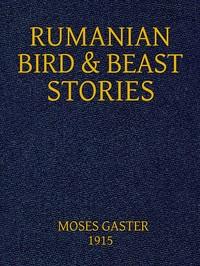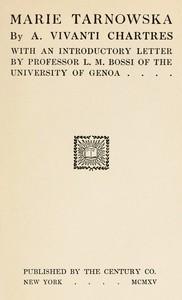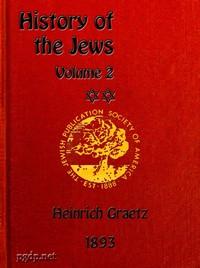|
|
Read this ebook for free! No credit card needed, absolutely nothing to pay.Words: 100828 in 32 pages
This is an ebook sharing website. You can read the uploaded ebooks for free here. No credit cards needed, nothing to pay. If you want to own a digital copy of the ebook, or want to read offline with your favorite ebook-reader, then you can choose to buy and download the ebook.

: Rumanian Bird and Beast Stories Rendered into English by Gaster Moses Translator - Folklore Romania@FreeBooksWed 07 Jun, 2023 creation tales of animals is an additional support of the view that the fairy tales have not been "edited" or adapted to cosmogonic purposes to explain the origin of beast and bird. Fairy tales are, as a rule, taken out of the range of the survival theory. The similarity of fairy tales, so striking among a large number of nations, precludes the possibility of seeing in them local survivals, and yet it appears unscientific to separate one section of oral literature from the other. The line of demarcation between creation legend and creation fairy tale is so thin that it is often indistinguishable. Both spring from the same root, and the theory that endeavours to explain the origin of the one must also be applicable to the other. In the theory of survivals, however, no attempt is made to deal at the same time with the question of origins. It has not yet been made clear, by any of the more prominent representatives of the theory of survivals, how the similarity in customs and ceremonies is to be explained, in tales and fables, between the most diverse nations living separated from one another. If these survivals represent local tradition, which has persisted throughout the ages, how, then, does it come to pass that they should resemble so closely other ceremonies and customs observed by different nations also as local traditions? Is it to be inferred that at some distant time, far back in the prehistoric ages, some such ceremonies were used, that, in spite of evolution and separation, they have survived everywhere almost unchanged, in spite of the profound modifications of the nations in their ethnical, political and religious status? Either they are local inventions, in which case they could not resemble any other, or they all go back to one common stock, and have survived in such a miraculous manner contrary to every law of human nature. The only explanation feasible and satisfactory is, I believe, the theory of transmission from nation to nation; those resembling one another closely in modern Europe are not of so early an age as has hitherto been assumed, but have come at a certain time from one definite centre, and were propagated among the nations, and disseminated by means of a great religious movement at a time when the political and national consolidation of the peoples of Europe had already assumed a definite shape. To this conclusion we are forced by the examination of these Rumanian animal tales in their manifold aspect, "creation" tales, fables, fairy tales. They are all more or less of comparatively recent origin. They owe their actual shape to the dualistic teaching of the Manichaeans and Bogomils. They have come by these intermediaries of the religious sects from Syria and the Balkans. These tales stopped first among the nations in the Near East, and then by the same agency were carried to the extreme West. Only in such wise can we explain the appearance of these tales--whatever their archaic character may be--among nations of comparatively recent origin like those now under consideration, Rumanians, Bulgars, Russians and even Saxons and Hungarians. This is the only possible explanation of the very remarkable dualistic character, and of the peculiar teachings embodied in these tales. For, whatever these nations have in common, there cannot be any question of survivals, for the reasons advanced above. All the nations are comparatively modern. It is impossible to assume that what might be a Latin survival among the Rumanians could be so closely connected with what might be a Turanian survival among the Bulgars or a Pelasgian survival among the Albanians. There might be found among these tales traces of more ancient beliefs, myths and customs, just as it is possible to find similar traces among the folk-lore of the nations of the West. But what I contend is that these are not local survivals--that, whatever their primitive character may be, they need not originally belong to the nations among whom they are found now. They were brought by the same movement that brought the tales and legends, customs and ceremonies. The new and the old were carried along by the same stream of tradition and religious influence. An adjustment and readjustment of materials, the placing of layer upon layer, localisation and assimilation then took place. But these are rocks swept along by the stream and deposited far away from the place of origin, or, to take another simile, that of the insect and the amber. The amber has been carried from the North Sea many centuries ago, nay, thousands of years ago, along the trade routes from North to South, and has found its way also to ancient Egypt. Embedded in the amber we have here and there a North European insect which was caught at the time when the amber was still a liquid, and, imprisoned in it, became fossilised, and was carried a long distance. If found, then, among the beads in the tombs of the ancient Pharaohs, no one could say that that insect was of Egyptian origin, or that fly a remnant of the local fauna. It had come thither together with the amber that carried it, and may have remained there if the amber had decayed. In the same manner ancient customs, ancient beliefs and ancient tradition have been caught in the liquid tales, apologues and legends, like the fly in the amber, and carried along with them from East to West. In this manner they may perhaps be termed survivals, but survivals of a different kind than has been assumed hitherto. They have survived only as long as they were tolerated in the lore of the people. Hand in hand with dissemination go the assimilation and localisation of these diverse elements. It is impossible to do more within the compass of this introduction than merely touch the fringe of a far-reaching problem which arises from the examination of these peculiar beast and bird tales. One of the most instructive examples of this religious syncretism, of the manner in which it has influenced the people, and the form in which it has been preserved, localised, and assimilated, among them, is shown to advantage in the stories of the origin of the Glow-worm and in the stories of the Bee. Some of the cosmogonic legends of the Rumanians are also found among the Balkan people. They are a fragmentary reflex of a great conception of the world. If I may use the mystical and symbolical language of the legends, they are also sparks from a great light that had fallen down from heaven. The creation of man, the fall of the angels, are here curiously blended together. They represent part of the teaching that went under many names but, in essence, was one. That is, of course, the belief in the dualism of the creative powers, the good God and the wicked one, styled Satan. From these tales and legends, which are derived from well-known apocryphal writings, we can see how deeply the latter have entered the life of nations which have not yet fallen under the unifying sway of strict dogmatism, and how unable the people are to grasp the higher spiritual interpretations of the dogmas and practices of the Church. From a purely dogmatic point of view, all these tales are rank heresy; but who among the simple folk knows the distinction between orthodox and heretical teaching? The people are more easily disposed towards a simple philosophy which explains satisfactorily the phenomena of life. They listen with pleasure to tales of imagination. One of the fundamental theories of Gnosticism or, rather later, of dualism, is this peculiar conception of the creation. The world is divided between the power of light and the power of darkness. The latter is anxious to participate in the possession of light, and for that reason steals some, which it breaks up into sparks and covers over with thick matter so that it may not escape. These sparks are the human soul deeply embedded in human clay, anxious always to be reunited with the ancient glory. In this Gnostic teaching we have the very source of the legend of these angelic sparks now relegated to glow-worms, originally placed in other "earthly worms"--the human race. We hear, moreover, the faint echo of the fall of the angels and of the angels of a lower rank inhabiting the planets and the stars. We even have the legend, found in the Book of Enoch, of the angels who fell in love with a woman and remain upon earth as evil spirits, whilst she is translated to heaven and becomes a star. The interest lies not only in the fact that these ancient religious conceptions have been so faithfully preserved among the people, but also in the manner of their preservation. They have been adapted to the understanding of the folk, and, from dogmatic teachings, they have become beautiful popular legends. But the inner meaning has been entirely lost. The old sparks have been embedded in very thick clay indeed, as can be seen in the treatment meted out to God, Christ, the Virgin, the Apostles and Saints. They are greeted with an apparent lack of reverence and respect that must disturb the equanimity of people of a Puritanic mind. The gods could not have been put on a footing of greater familiarity; it almost borders on the burlesque. Primitive nations show the same apparent want of respect to their gods, idols or fetishes, and we are inclined to put them on a lower scale of faith and reverence than the peoples of Europe. A better knowledge of the life and religion of the peoples in the East and of the Eastern part of Europe would soon change such a view. In fact, I believe, that if we could descend to the lower depths of the masses of Western Europe, and especially of those in Catholic countries, and get a peep into their innermost soul, we should not find it very different from that of the Slav and the Rumanian. The Saints are not treated differently in Spain and in Italy on the one hand, or in Rumania and in Bulgaria, or even Russia, on the other. They have all the same essential conditions in common, viz. all have a Pantheon of Saints of various degrees and of both sexes. In Protestant countries the people have been impoverished. All the saints have been driven away; a cold abstract spirituality has taken their place, and yet depth of fervour and strength of belief cannot be denied to these Eastern peoples. There is, moreover, a sufficient fund of humour and innate rectitude to keep them at a certain level of morality and albeit free from the hypocrisy of the so-called higher civilization. So that, if the Rumanians take liberties with God and the Church and the Saints, and pay homage to the Devil by mocking and laughing at the jokes which God performs for his confusion, it is all done more in the spirit of good-natured banter, not in that of polemical or fanatical intolerance. Why should the poor Devil not also occasionally have a good time? He is always sure to be outwitted in the long run. I am fully aware of the objection that may be raised against attributing so much influence to the activity and propaganda of the heretical sects. It may be argued, that their influence was not in any way commensurate with the results ascribed to them, that they did not carry the masses with them to such an extent as to leave indelible traces on their religious life and popular imagery. Some may go so far as to look upon their activity as similar to that of some of the mendicant friars during the Middle Ages. Yet the mendicant friars were able to exercise a tremendous influence upon the people and, helped by other political powers, they were able to create a movement which led up to the Crusades. It seized upon the masses of Europe with an irresistible force. In a minor, yet no less effective manner, the same agencies were able to arm the Kings of France against the Albigenses in Provence. Church history, however, shows very clearly that the power of the Manichaeans was so great that it has taken the Church many centuries to bring the fight to a satisfactory close.--The Cathars have given the name Ketzer to the German heretics, and every language in Europe shows traces of this heretic nomenclature.--The struggle was a terrible and a long one, and if it had not been for the secular arm which placed itself at the service of the Church for political reasons, who knows whether the Romish Church would have come out victorious in the struggle? The question may be asked, How did it come about, that the teaching of an obscure sect could be propagated from the Black Sea to the Atlantic and could win the support of so many peoples? The answer lies in a fact which has hitherto been entirely ignored. The connection between Arianism and Manichaeism in Europe has to my mind not yet been even hinted at; yet there must have been a very close and intimate one. Arianism, in fact, prepared the ground for the new wave of heretical teaching which, a few centuries after the former's official extinction, followed in its wake. No one has, as yet, endeavoured to trace the effect which the Arian teaching has had in Europe when it became the national faith of the Goths. In them we have a nation which, from the third century to the end of the sixth, practically dominated central Europe. It established more than one kingdom between the Black Sea and the Atlantic, in Illyricum, in Northern Italy, one of might and strength in the South of France in Provence, with its headquarters in Toulouse. It had overflowed into Spain, and broke down only after the invasion of the Arabs. These Goths are described as rude barbarians, because they differed in their life, and probably in their original forms of faith, from the Greeks and the Romans. The modern idea is that their original home was somewhere in the North-West of Europe, that they came along the Vistula, and then migrated to the country between the Don and the Ural. Free books android app tbrJar TBR JAR Read Free books online gutenberg More posts by @FreeBooks
|
Terms of Use Stock Market News! © gutenberg.org.in2025 All Rights reserved.






